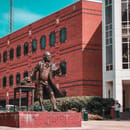It’s that time of the year again. Whether you are graduating from college or entering your sophomore year, many of you are looking for internships or jobs in the summer. Job searching is an exhausting process. It can be discouraging when you apply to a list of positions and only hear back from one or two, or even none. Even when you’re fully qualified for the position, sometimes your resume just seems to be thrown into a black hole.
Before we dive into how to optimize your resume to land that interview you deserve, we have to first understand how the recruiting process works.
More often than not, you submit your resume and cover letter on a company’s job portal or a recruiting website. With thousands of applications being submitted, it is impossible for recruiters to look at every single one in detail when selecting candidates to interview. Because of this, companies utilize applicant tracking systems (ATS) to scan relevant keywords on all the submitted resumes and select top candidates to be viewed by a human recruiter. From there, they pick candidates to move forward with the interview process.
Resume writing is a science.
Related: 10 Ways to Dramatically Improve Your Resume
“What keywords should I be using on my resume?” you might ask.
The keywords the applicant tracking system looks for are keywords from the job description. When writing your resume, it is important for you to have your resume and the job description up side by side. You should read the job description carefully and identify keywords.
These keywords include:
-
Action verbs – for example: wrote, drafted, designed, developed, analyzed, etc.
-
Software — for example: Canva, Adobe Suite, Final Cut Pro, Cision, Hootsuite, etc.
-
Previous experience — for example: internship specific to the industry.
-
Industry-specific terminologies — for example, for the communication industry: press releases, pitches, media lists, AP style and messaging would be relevant keywords; for the business or sales industry: sales pipeline and customer lifecycle would be keywords.
-
Skills — for example: research, communication, organization, collaboration, and leadership skills.
These keywords are usually found in the qualification and responsibilities section of the job description. Figure out what they are expecting from an ideal candidate. What skills do they want you to have? What software do they want you to know? What previous experience are they expecting from you?
Make sure you have those keywords on your resume, whether it be on your relevant coursework section, skills section, work experience bullet points, or even extracurricular activities section.
Related: 5 Unconventional Ways to Stand Out to Employers
Now that you have the important keywords on your resume. We have to ensure the applicant tracking system identifies it.
Submitting your resume in a Word document is the safest way to allow the applicant tracking system to search for keywords on your document. A PDF file is a good way to keep everything well-formatted, however, it is not the safest option since some applicant tracking systems may fail to track text from PDF files.
When using a Word document, make sure to use a plain document instead of a template. While resume templates are more aesthetically pleasing and stand out more, applicant tracking systems may not be able to scan the texts inside the template.
Using a plain document and decorating your resume without using a template would be your safest way to increase your chances of landing an interview. However, this makes it hard for you to showcase your graphic design skills and your dedication like you would through a graphic resume. A trick I have been using for my resume submissions is by having a PNG file of my graphic version of my resume on the first page of my Word document. Then, I will have my plain Word document resume on page two of the document.
This way, the applicant tracking system would be able to track the keywords from my document, at the same time, once a recruiter looks at the resume, they can see the graphic version of the resume and see the work that I put in on my graphic resume.
On the other hand, if you’re submitting your resume to a specific contact through email, perhaps someone you met at a Career Fair or a recruiter at a smaller-scale company, the applicant tracking system process doesn’t apply. Still, you should align your resume with the job description and use important keywords to show that you are a strong candidate. However, you can have the liberty to submit a PDF file of a graphic resume you made with Canva or the Adobe Suite without worrying the recruiter won’t see it.
Resume writing is not an easy job and is something that takes time to strengthen. These tips will help lead you in the right direction. Good luck, collegiettes!



